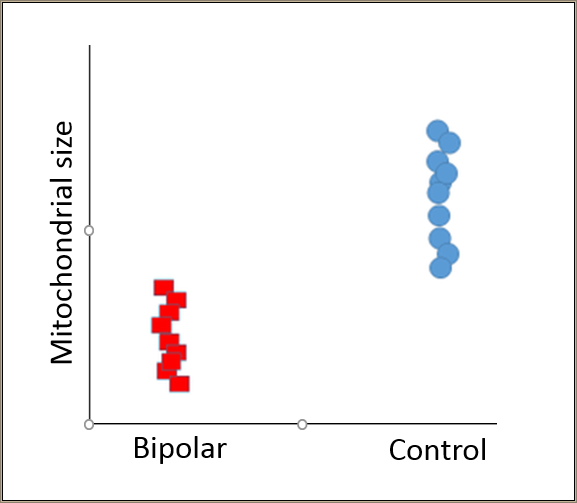Article
Mitochondrial Clues to Bipolar Disorder
Author(s):
One of the many facets of bipolar disorder is an energy problem-including at the neuronal level.
©Luxorphoto/Shutterstock

Figure

RESEARCH UPDATE
Thanks to diligent bench research, we may be edging closer to seeing the mystery of bipolar disorder explained. What differs between the neurons of someone with the condition, and those of an unaffected individual?
We are like internists just before insulin was discovered: diabetes was understood in many ways-its symptoms, its course, exacerbating factors like weight gain-but its mechanism at that point remained unknown. Sugar in the urine, yes, but why? Mania and depression, obvious in their full forms; yes, but why?
Neuronal mitochondria might be central to the answer, according to recent research. The Figure shows one of the key results, schematically: hippocampal mitochondrial size differs markedly between patients and controls.
I’ll link you to the paper in a moment, but it will help to know how these results were derived before you encounter the original graphs. They are, well, dense, shall we say; and the cells studied are unusual.
Using pluripotent stem cells
Think about it: how did the researchers get hold of live hippocampal neurons? No brain biopsies here: the neurons were grown. While we clinicians have been busy taking care of patients, the cellular biologists have been figuring out how to create stem cells from fibroblasts. Yes, stem cells like those controversially obtained from unimplanted fertilized eggs during in vivo fertilization procedures.
Now the bench scientists can induce an adult’s fibroblasts to revert to stem cell status, with all the broad potential of a completely undifferentiated cell. These “induced, pluripotent stem cells” (iPSCs) can be instructed to become hippocampal neurons. Amazing, isn’t it?
Thus, a research team was able to take fibroblasts from patients with bipolar disorder, and another set from control subjects, then turn those fibroblasts into hippocampal neurons-and then look for differences between the 2 sets of cells. Their paper, published in Nature, a top journal for such findings, describes differences in mitochondrial RNA expression, cellular activity, and mitochondrial size between patients and controls.1
The size difference in particular is notable, as characterized in my schematic Figure: while there are variations from person to person, for about 80% of the bipolar patients, hippocampal mitochondria were smaller than even the smallest of the control subjects’ mitochondria.1 (See for yourself in their original Figure 1: focus on Figure 1n; then work backwards from there if you want to see further details).
Response to lithium
The research team is an international collaboration that includes a central group from the Laboratory of Genetics at the Salk Institute in La Jolla, California. This team also found that hippocampal neurons (iPSCs) from patients with bipolar disorder were “hyperexcitable” in terms of their electrical activity. Bathing the cells in a solution containing lithium at levels we use in a patient with acute mania-1.0 mEq/L-reduced this hyperexcitability in most of these artificially created neurons.1
The research team has gone on to show that the electrical activity of these iPSCs can be used to predict response to lithium with 92% accuracy.2 Of course, at present it would be too arduous to obtain a patient’s fibroblasts (by punch biopsy), induce those cells to convert to pluripotent stem cells, train them to become hippocampal neurons, then test their electrical responses, in order to determine whether lithium is likely to be an effective anti-manic treatment.
But this basic science work has provided a human cellular model for bipolar disorder. It has already enabled a closer look at where, exactly, things are different in the brains of people with bipolar disorder. The results point toward the mitochondria in hippocampal neurons (and perhaps elsewhere-that’s yet to be examined). Think of patients who describe their bipolar depression as “like thinking through mud”; or their hypomania as “like watching 7 television stations at once.” One of the many facets of bipolar disorder is an energy problem-including at the neuronal level.
Acknowledgment: Thanks to colleague John Gottlieb for calling my attention to the more recent study.
Disclosures:
Dr. Phelps is Director of the Mood Disorders Program at Samaritan Mental Health in Corvallis, Ore. He is the Bipolar Disorder Section Editor for Psychiatric Times. Dr. Phelps stopped accepting honoraria from pharmaceutical companies in 2008 but receives honoraria from McGraw-Hill and W.W. Norton & Co. for his books on bipolar disorders.
References:
1. Mertens J, Wang QW, Kim Y, et al. Differential responses to lithium in hyperexcitable neurons from patients with bipolar disorder. Nature. 2015;527:95-99.
2. Stern S, Santos R, Marchetto MC, et al. Neurons derived from patients with bipolar disorder divide into intrinsically different sub-populations of neurons, predicting the patients’ responsiveness to lithium. Mol Psychiatry. 2017 Feb 28. doi: 10.1038/mp.2016.260. [Epub ahead of print]






